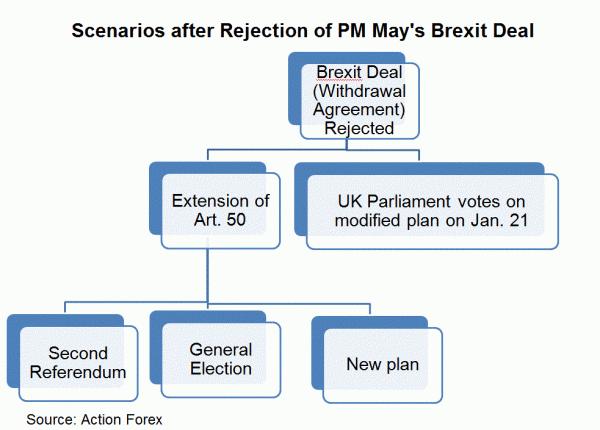The UK Parliament rejected the Brexit deal (Withdrawal Agreement) proposed by PM Theresa May at 432 to 202 votes. The 230- vote margin marks the biggest defeat in the country’s political history. The government now has three days to work on a new plan, which has to be agreed by Europe and presented to parliament again by the close of business on January 21 (Monday). Meanwhile, opposition Labor Party leader Jeremy Corbyn has tabled a no- confidence vote. With 73 days left before the UK’s exit from the EU on March 29, what the next step is remains highly uncertain. Ironically British pound strengthened amid uncertainty, as the market hopes that an extension of Article 50 and a possible second referendum would greatly reduce the chance of no-deal Brexit while increasing the likelihood of remaining in EU (the most GBP positive scenario).
In this report, we lay down several scenarios that could happen upon rejection of the deal. We agree that an extension of Article 50, follower by a second referendum, is the most likely scenario. Yet, we refrain from overtly optimistic over GBP’s outlook, mainly as the risk no- deal Brexit is truly eliminated.
A. Passage of a Modified Deal before March 29
PM May’s administration now has three days to modify her plan. Since the parliament does not sit on Friday, it has by next Monday to present a new proposal to the parliament. Note, that the new proposal has to be agreed unanimously in the European parliament beforehand. We believe this is nearly impossible. A plan that could be accepted by the majority in the UK parliament would require amendments on the Irish backstop, which is unlikely to be compromised by the EU.
B. Extension of Article 50
As time is running short before the official day of leaving the EU arrives, it is likely that PM May would seek to extend Article 50, buying time to implement one or some of the followings:
i) Second referendum
This is what the market generally expects would happen. Sterling’s rally amidst such hopes lies on the assumption that the UK citizens would vote for “remain” or “Brexit with May’s deal”. Both cases would preclude a “no-deal Brexit”.
The trick here is on the question being asked the ballot paper. According to UK’s Institute for Government, most referendums offer voters a binary choice between 2 options. Yet, since there are at least 3 possible outcomes for the case of Brexit: May’s deal, no- deal Brexit, or remaining in the EU, a binary- option referendum (e.g.: deal vs no-deal, or deal vs remain) would be vigorously opposed by those in support of the excluded option.
A problem created by a ternary voting (referendum with three options) is that the most popular option could be implemented without support of a majority of voters. Regarding this, some suggested that voters could rank their choices in order of preference. The least popular first choice would be eliminated, and its votes reallocated based on second preferences. Others propose that the referendum could include two separate questions. Question 1 could ask whether voters wish to Leave or Remain, as in 2016. Question 2 could ask voters to select between the two different models of Brexit, if there is still a pro-Leave majority. In both cases, “no- deal Brexit” would still be a referendum option, meaning that the risk of UK exiting EU without a deal is not truly eliminated.
ii) A New Deal
Similar to the scenario of “passage of a Modified Deal before March 29”, the biggest conflict between UK Parliament and EU is on the Irish backstop. We see remote possibility of eventual compromise on this issue, even after Article 50 is extended.
iii) General Election
The MPs would vote on the no- confidence motion tabled by Labor Party leader Corbyn later this week. We doubt if it would be passed since it requires support of some Tory/ DUP MPs. Should Corbyn’s motion be passed, it might not automatically trigger a general election. Indeed, another election is not practical. The market does not expect a new government could resolve the deadlock currently facing Brexit. Meanwhile, a Labor-led government could be negative for the pound as it takes time to assess a new government from the opposite end of the political spectrum and the market is skeptical over the party’s welfare policy stance
C. No- Deal Brexit
As we can see, the chance of no-deal Brexit is not entirely eliminated unless a modified plan is approved by the UK Parliament by next Monday or the government manages to secure a new deal the extension of Article 50.















